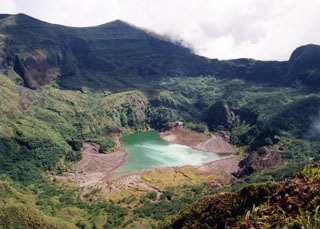Report on Awu (Indonesia) — 11 May-17 May 2022
Smithsonian Institution / US Geological Survey
Weekly Volcanic Activity Report, 11 May-17 May 2022
Managing Editor: Sally Sennert.
Please cite this report as:
Global Volcanism Program, 2022. Report on Awu (Indonesia) (Sennert, S, ed.). Weekly Volcanic Activity Report, 11 May-17 May 2022. Smithsonian Institution and US Geological Survey.
Awu
Indonesia
3.689°N, 125.447°E; summit elev. 1318 m
All times are local (unless otherwise noted)
PVMBG had raised the Alert Level for Awu to 2 (on a scale of 1-4) on 12 December 2021 because of a notable increase in the number of both shallow and deep volcanic earthquakes. Since then the number of shallow and deep volcanic earthquakes averaged 8 and 5 events per day, respectively. Gas emissions had not been visible, though weather conditions sometimes prevented views of the volcano. Another significant seismic increase was recorded on 9 May, with 88 shallow events and 147 deep events, and then again the following day with 90 shallow events and 203 deep events. At 1500 on 11 May a white emission was observed rising about 30 m above the crater rim. The Alert Level was raised to 3, and the public was warned to stay at least 3.5 km away from the summit crater.
Geological Summary. The massive Gunung Awu stratovolcano occupies the northern end of Great Sangihe Island, the largest of the Sangihe arc. Deep valleys that form passageways for lahars dissect the flanks of the volcano, which was constructed within a 4.5-km-wide caldera. Powerful explosive eruptions in 1711, 1812, 1856, 1892, and 1966 produced devastating pyroclastic flows and lahars that caused more than 8000 cumulative fatalities. Awu contained a summit crater lake that was 1 km wide and 172 m deep in 1922, but was largely ejected during the 1966 eruption.
Source: Pusat Vulkanologi dan Mitigasi Bencana Geologi (PVMBG, also known as CVGHM)

